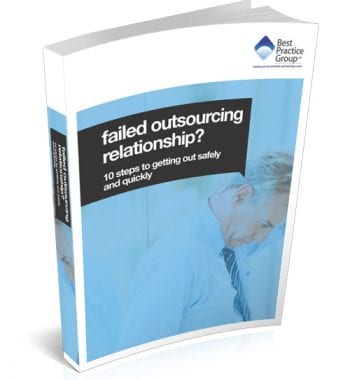 Less than half of all strategic supplier relationships achieve the business outcomes the client expects. Just let that sink in for a moment. This means that over fifty per cent of clients are wondering where it all went wrong.
Less than half of all strategic supplier relationships achieve the business outcomes the client expects. Just let that sink in for a moment. This means that over fifty per cent of clients are wondering where it all went wrong.
This latter half, however, are not a monolithic group. They fall onto a spectrum, from those whose relationships have strayed, but may be recoverable (even if they don’t achieve all of their goals), to those whose relationships have passed the point of no return and the only way to proceed is to step away as carefully, quickly and respectfully, mitigating as much reputational and financial damage as possible.
If you ever find yourself falling into this category, it’s important to recognise that exiting really is a last resort strategy. Exiting from your strategic supplier relationship can be costly, challenging and will certainly have a wide-ranging and long-lasting impact on your ability to achieve the business outcomes you originally wanted the strategic supplier to support. This is why it should only be considered once all efforts to resolve any trust or performance issues have been attempted and have failed to provide significant improvement.
Supplier Exit Management Strategy
Should you find yourself in this situation we have a step-by-step objective guide that may interest you. This article looks to summarise the detail of that guide, offering a brief overview of the ten key steps to consider should you consider that a supplier exit management strategy be the only option left to you.
-
-
The cost of haste
-
If you have clear evidence that your supplier is simply unable to remediate the service issues they are contracted for, that may be enough, but only if you have done your bit as a client. As an example, if your dispute reaches a higher court (such as the Technology and Construction Court, in which disputes regarding strategic supplier relationships are usually heard), there will likely be an expectation that you have worked with your supplier to give them every reasonable opportunity to remediate the services and improve their performance, all within a sensible time frame.
Not giving your supplier a reasonable opportunity to remediate its performance is likely to cost you financially and reputationally if it is determined that you did not go to all reasonable lengths to engage with your supplier to find a way forward before deciding to exit the relationship.
So, despite the stresses and strains of working in a dysfunctional relationship, and the way emotions can become heightened in these times, it’s always best to pause, take a breath and consider your next move very carefully before you choose to consider stepping away from your strategic supplier.
-
-
Determine opportunities vs threats
-
Do you have a full and complete understanding of the implications of exiting your strategic supplier relationship? How will your business outcomes from the service they provide suffer, what delays might be involved, who will this impact, will there be a reputational backdraft, what will it cost, can the service be replaced (see point 3 below), how quickly can it be replaced, and so on?
Build a full and complete business case for exiting so that you make an informed choice which can be clearly presented and quantified should anyone ask, no matter which way you choose to go on this question.
-
-
Who will carry out the replacement service?
-
It’s an obvious question, but, in the absence of your existing supplier, who will be taking over from them. Presumably the demand is still there, so where will the supply come from? There are essentially three options: bring it in-house so your own team can handle it, offer all the services to another primary supplier, or a hybrid version where some parts are provided by a new supplier and the rest is done in-house.
This then raises further considerations – do you have the capacity and talent in-house, do you have a back-up supplier in mind, will there be any negative impact from transitioning to them, and what service levels would need to be achieved from any of these options for you to meet or surpass the service you had been receiving up until this point? All appropriate due diligence should be completed ahead of exiting your existing relationship.
-
-
Exits can be more challenging than entrances
-
It is always good to be a realist in these matters and the reality here is that no exit is easy, there is never a completely stress-free, swift and simple solution, there is only an attempt to minimise the impact on your service delivery. An early or forced exit requires meticulous planning and scheduling so you can reduce the potential for disruption and manage the exit effectively.
-
-
Evaluate your exit evidence
-
Objective evidence of your supplier’s performance failure is critical. If the supplier’s service is genuinely failing, but your team has not put together both clear evidence of (1) the supplier’s failures, and (2) your team’s attempts at genuinely supporting the supplier to improve its performance, then you will have significant challenges in either mediating, arbitrating, expert determination or litigation to achieve a successful outcome.
It’s not about collecting detailed evidence to justify your position. It’s about objectively evaluating the service being provided and the evidence that supports how well or badly the supplier has performed that service.
In any early termination of a contract, the supplier’s senior management team (and its shareholders) will want to know that you as the client haven’t simply ‘changed your mind’ and are trying to surreptitiously manufacture a way out of the contract.
Your supplier will likely push back on early termination of a contract where its service is perceived as poor by the client. The supplier (and/or its legal/commercial advisers) will always look for evidence (sometimes subjective) of where the client’s action or inaction has contributed to (or even prevented) the supplier being unable to provide its services effectively, thus giving the supplier the opportunity to refute your allegations and claim significant sums against you for wrongly trying to terminate the contract early.
Having objective evidence articulating that the service performance has been poor and that you have genuinely tried to work with the supplier to remediate performance issues, means you will have a much better opportunity to come to a sensible decision between you to be able to part company in a constructive manner. Objective evidence usually reduces legal fees, speeds up the time to replace the service, lessens the chance of ongoing acrimony between you and your supplier and allows everyone to concentrate on their respective business(es) going forward.
Note that in objectively assessing your evidence, special attention should be paid to any ‘expert’ responsibilities your supplier may have taken on (contractually or implied) once they have provided you with guidance at any point in your relationship, from your pre-contractual discussions with them onwards.
-
-
Rate and rank the significance of your evidence
-
Not all evidence is collated equal. It’s important to recognise that for evidence to validate that the only way forward is an extreme action, such as exiting your strategic supplier relationship early, it must objectively show clearly and unequivocally that the issues you are facing are significant enough to warrant such a move and, despite significant support from you to the supplier, that those performance issues were unable to be remedied.
Rate the impact of each piece of evidence that you gather and rank them from most to least important. Then, once you have all of this information, consider the impact each has to affect those who rely on the service and the reputation of your organisation. Sanity check your perspective (often by asking for an external and independent view), and you’ll be able to determine if this is enough reason to proceed.
-
-
Formal or informal exit process?
-
There is more than one way to exit from your strategic supplier relationship. Ranked from least to most formal you have:
-
-
- Negotiation
- Mediation
- Expert determination
- Arbitration
- Litigation.
-
Each has its own benefits and weaknesses, so it is important to select the one best suited to your end goal in this process. Note that the Civil Procedure Rules insist that some form of mediation should take place before formal litigation.
Naturally, the less formal the forum you select the greater the likelihood of a faster and more practical outcome.
-
-
Time for talk
-
After all of your analysis and preparation, it’s now time to speak directly with your supplier. They have not only been your partner in product or service delivery up until now, they must also be your partners in this exit process, as working with them, as opposed to against them, has the capacity to sweep many of the issues and obstacles out of the way.
The first thing to do is to encourage your supplier that it is in their best interests to support you in your move to exit early from your relationship (or at least not to oppose it too strongly). The objective evidence that you have gathered and validated as strong enough to warrant this extreme move will go some way to achieving this, but it is the way in which you present this evidence to your supplier that will determine whether they feel inclined to help make the exit a quick and painless experience or not.
-
-
Please move to the exit
-
You’ve determined that an exit is necessary, calculated the impact, gathered evidence to support this view and discussed the matter, delicately, with your supplier so they are now on side (as much as can be expected) with the decision. Now it’s time to manage your exit. Much like any other aspect of your relationship, travelling through its ending must be carefully planned and managed so you can be sure that all contractual rules and responsibilities are adhered to and that you traverse the exit road at a pace in line with your schedule.
-
-
External support and guidance
-
Reasons for instructing outside help in an early termination are many. A few include professional detachment to increase the possibility of a civil relationship with your ex-supplier post exit, someone unencumbered by relational connections to provide an impartial view and professional guidance, and an opportunity to tap into the expertise of specialists who have been through a significant number of these exits. With their support you may be able to get services running more effectively with a new service provider, even if that service provider is your own in-house team. The right external support can streamline your exit process, sign off on every step to ensure you are on track with all you need, and help you to avoid costly mistakes.
What now?
Now that you’ve read the overview, if you find yourself in this situation (now or at any time in the future) it may well be worth your while taking a look at the step-by-step guide we’ve produced on the subject – Do you have a Failed Outsourcing Relationship and need to exit early? – which investigates each of the above points in far more detail, with guidance and plenty of tips for a swifter and smoother exit from your strategic supplier relationship.
If you wish to gain an external perspective, to instruct independent specialists to support you in your exit planning and execution, then we’d be happy to speak with you to see whether our work on hundreds of complex strategic relationships can benefit your particular situation. Contact us on 0845 345 0130 or email advice@bestpracticegroup.com

